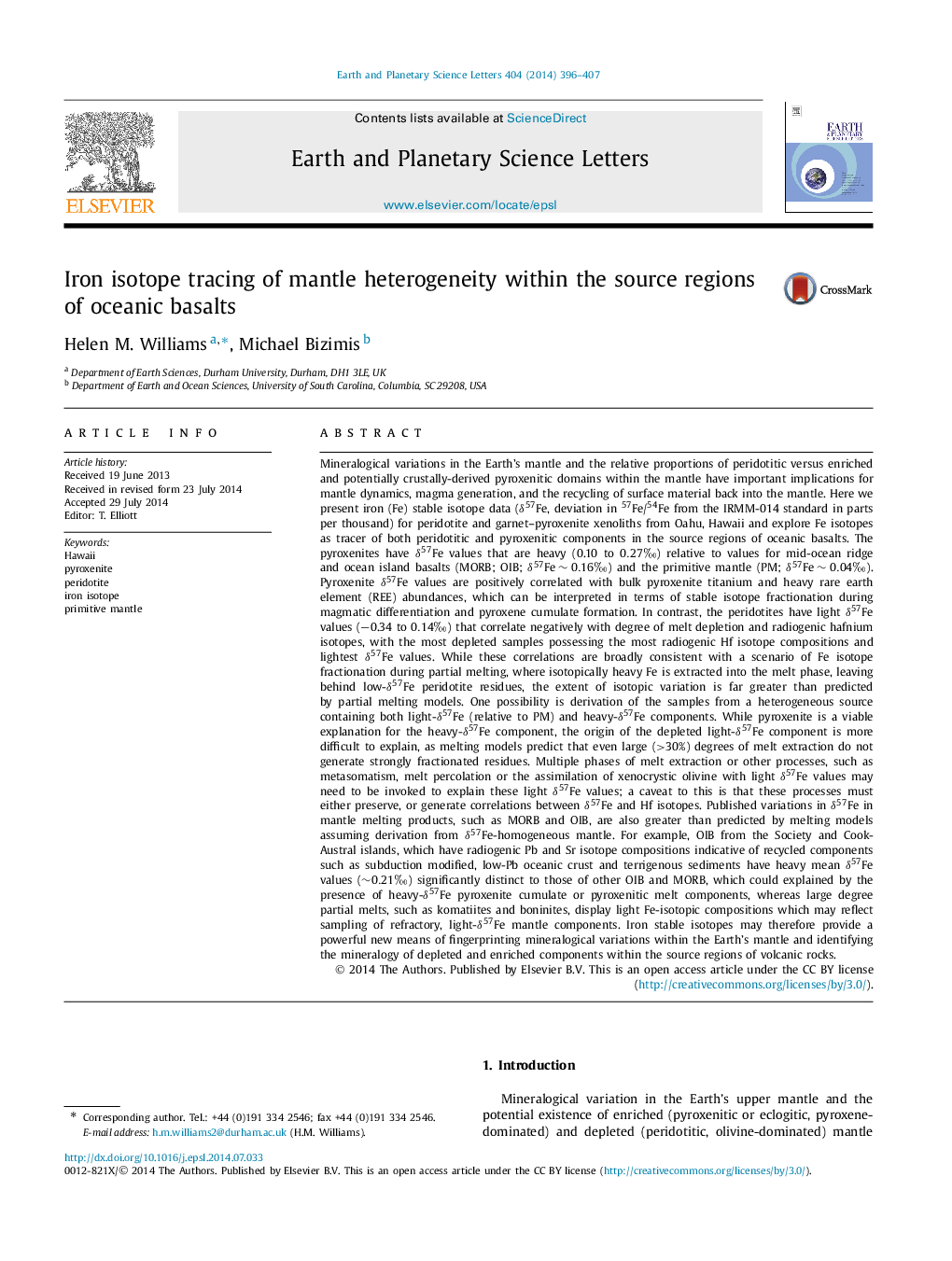| کد مقاله | کد نشریه | سال انتشار | مقاله انگلیسی | نسخه تمام متن |
|---|---|---|---|---|
| 6429069 | 1634752 | 2014 | 12 صفحه PDF | دانلود رایگان |
• Refractory peridotite and cumulate pyroxenite display systematic differences in Fe isotope composition.
• Fe isotopes provide evidence for cumulate pyroxenite in OIB source regions.
• Fe isotopes record the melt depletion and enrichment history of the upper mantle.
• The Fe isotope composition of the Earth's upper mantle is heterogeneous.
Mineralogical variations in the Earth's mantle and the relative proportions of peridotitic versus enriched and potentially crustally-derived pyroxenitic domains within the mantle have important implications for mantle dynamics, magma generation, and the recycling of surface material back into the mantle. Here we present iron (Fe) stable isotope data (δ57Fe, deviation in 57Fe/54Fe from the IRMM-014 standard in parts per thousand) for peridotite and garnet–pyroxenite xenoliths from Oahu, Hawaii and explore Fe isotopes as tracer of both peridotitic and pyroxenitic components in the source regions of oceanic basalts. The pyroxenites have δ57Fe values that are heavy (0.10 to 0.27‰) relative to values for mid-ocean ridge and ocean island basalts (MORB; OIB; δFe57∼0.16‰) and the primitive mantle (PM; δFe57∼0.04‰). Pyroxenite δ57Fe values are positively correlated with bulk pyroxenite titanium and heavy rare earth element (REE) abundances, which can be interpreted in terms of stable isotope fractionation during magmatic differentiation and pyroxene cumulate formation. In contrast, the peridotites have light δ57Fe values (−0.34 to 0.14‰) that correlate negatively with degree of melt depletion and radiogenic hafnium isotopes, with the most depleted samples possessing the most radiogenic Hf isotope compositions and lightest δ57Fe values. While these correlations are broadly consistent with a scenario of Fe isotope fractionation during partial melting, where isotopically heavy Fe is extracted into the melt phase, leaving behind low-δ57Fe peridotite residues, the extent of isotopic variation is far greater than predicted by partial melting models. One possibility is derivation of the samples from a heterogeneous source containing both light-δ57Fe (relative to PM) and heavy-δ57Fe components. While pyroxenite is a viable explanation for the heavy-δ57Fe component, the origin of the depleted light-δ57Fe component is more difficult to explain, as melting models predict that even large (>30%) degrees of melt extraction do not generate strongly fractionated residues. Multiple phases of melt extraction or other processes, such as metasomatism, melt percolation or the assimilation of xenocrystic olivine with light δ57Fe values may need to be invoked to explain these light δ57Fe values; a caveat to this is that these processes must either preserve, or generate correlations between δ57Fe and Hf isotopes. Published variations in δ57Fe in mantle melting products, such as MORB and OIB, are also greater than predicted by melting models assuming derivation from δ57Fe-homogeneous mantle. For example, OIB from the Society and Cook-Austral islands, which have radiogenic Pb and Sr isotope compositions indicative of recycled components such as subduction modified, low-Pb oceanic crust and terrigenous sediments have heavy mean δ57Fe values (∼0.21‰∼0.21‰) significantly distinct to those of other OIB and MORB, which could explained by the presence of heavy-δ57Fe pyroxenite cumulate or pyroxenitic melt components, whereas large degree partial melts, such as komatiites and boninites, display light Fe-isotopic compositions which may reflect sampling of refractory, light-δ57Fe mantle components. Iron stable isotopes may therefore provide a powerful new means of fingerprinting mineralogical variations within the Earth's mantle and identifying the mineralogy of depleted and enriched components within the source regions of volcanic rocks.
Journal: Earth and Planetary Science Letters - Volume 404, 15 October 2014, Pages 396–407
